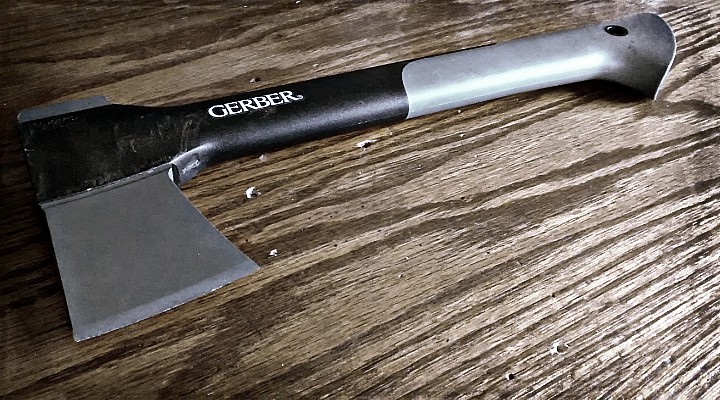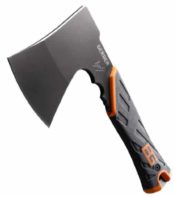
A Complete Guide On Finding (& Using) A Survival Hatchet
Because I think hatchets are a very underrated survival tool.
But only if you choose the RIGHT one.
And nowadays, there’s an overwhelming number of brands and types on the market.
- So you must learn what features and qualities are best.
- And which ones you should avoid at all cost…
That’s what we’ll cover today in this guide…
TOPICS IN THIS GUIDE… ↓(click to jump)
- Survival Axe Vs. Hatchet
- Basic Parts Of A Hatchet
- Amazing Hatchet Techniques
- The Many Survival Uses
- Pros And Cons Of A Hatchet
- New Hatchet Designs
- Should YOU Carry One?
- The Exact Hatchet I Carry
Survival Axe Vs. Hatchet
A hatchet is a type of axe.
It’s the smallest version of an axe with a hammer on the backside.
For example:
There are several categories of axes, such as Felling Axe, Forest Axe, Small Forest Axe, and Hatchet.
The hatchet is the axe in the smallest group.
A hatchet head weighs in the 1 to 3 lbs. range; it has a 3 to 5-inch blade and a 10 to 16-inch overall length.
These measurements are rough estimates since there are no exact standards for an axe to be considered a hatchet.
But hatchets are the lightest, shortest, and smallest axes available.
↓ New Gerber Bushcraft Axe and Hatchet
Basic Parts of A Hatchet
There are two essential parts of an axe or hatchet.
The blade and the handle.
It’s all there is to an axe or hatchet.
However, there are many facets of these 2 basic parts, such as:
Heel of Bit
- Bit/Blade
- Toe Of Bit
- Axe-Side/Cheek
- Poll/Butt
- Belly
- Shoulder
- Back
- Throat
- Grip
- End Knob
The Head
If you want a good hatchet, the head will be the most important part, so make sure its quality is high.
The head of your hatchet must cut…and cut well.
This is determined by sharpness (duh!) and the bit thickness.
If the area immediately behind the blade edge widens quickly, it will have a tough time getting good penetration, no matter how sharp the blade is.
Plus, it will tend to glance off a tree when swinging at a sharp angle instead of biting into the wood.
You also want to keep the head of your hatchet nice and smooth.
Any unnecessary abrasions or dings on the head (or cutting edge) will reduce penetration efficiency.
The Handle
The two primary aspects of a hatchet handle are the overall length and material.
The longer the handle, the better your ability to generate swing speed and force.
However, longer handles tend to weigh more and don’t fit in packs or bug out bags as easily.
Handle materials typically come in one of three options: metal, wood, or fiberglass.
Metal handles are strong and durable but are the heaviest of the three material options.
Wood handles are a decent choice since they are also rugged but can get slick if they get oil or lubricant.
You don’t want your hatchet slipping out of your grip mid-swing (that would be bad).
My favorite is the fiberglass handle.
Especially a hollowed-out fiberglass handle with a nice rubber grip.
Why? Because fiberglass is reasonably strong but light.
If it’s hollowed out, you’ll reduce weight significantly, and as long as it has a nice rubber grip, it won’t accidentally slip out of your hands.
Of course, I’m biased toward carrying my hatchet in my bug out bag.
So this type of handle might not be optimal for someone who isn’t planning on carrying it on a hike, backpacking, or bugging out.
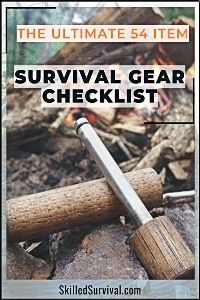
Want a free 54 item survival gear checklist?
Enter your email below to instantly download this Complete Checklist PDF. No purchase necessary. 👇 👇Balance
It’s always good to ensure your hatchet has a good balance.
It is preferable to have the balance point of an axe or hatchet be located on the handle right up against the head.
This balance location offers the best control for both swinging and carving tasks.
↓ Top 10 Best Hatchet For Survival and Bushcraft
The 3 Survival Hatchet Techniques
There are three basic hatchet uses:
- Chopping
- Splitting
- Carving
1. Chopping
A hatchet is an excellent tool for chopping smaller trees.
The larger a tree’s trunk size, the longer you chop.
Larger axes make large tree chopping easier, so remember this fact when choosing which trunk to attack with a hatchet.
Correct chopping technique is a vast topic, and I won’t cover it in the article.
However, I will say that you should plan your top and bottom attack angles to equal the trunk’s diameter.
So if the trunk is 4 inches thick, your total top and bottom cut gap should also be about 4 inches.
Check out this video for even more hatchet-chopping techniques and advice.
↓ Choosing A Proper Hatchet
2. Splitting
Splitting wood is necessary to make kindling.
It’s a relatively straightforward skill, but there are a couple of things to note when doing this with a hatchet instead of a full-sized axe.
First, I recommend you split wood from your knees and not stand up.
Hatchets are much shorter than standard-length axes, so if you try splitting a chunk of wood standing up and miss…the hatchet is going into your leg.
Also, don’t split wood on the ground.
This will prevent your hatchet from hitting the ground. Hitting the ground with your hatchet will ding the blade and damage your cutting edge…making it less effective.
↓ You’ve Been Splitting with a Hatchet Wrong!
3. Carving
To carve properly, slide your hand up to the head of your hatchet.
Now, slide the head of your hatchet down a piece of wood.
With this grip, you can control your bite angle pretty well, and you’ll also have a lot of leverage to power through sections as needed.
I find it easier to do rough wood carving with a hatchet than with a survival knife.
However, I prefer a sharp survival knife over a hatchet for detailed carving.
↓ Wooden Gransfors Bruks Axes
Maintaining Your Hatchet
Just a quick note on the maintenance of your hatchet…it’s very straightforward.
Maintain the blade sharpness like a knife by touching the edge with a sharpening stone.
Keep it dry, so it doesn’t rust, and that’s about it.
Also, you should learn how to sharpen your hatchet properly.
Another fantastic in-depth video from Wranglerstar.
↓ How To Sharpen An Axe
Here’s a solid Beginners Guide To Hatchets by Ross Gilmore that goes into more detail about choosing and using a hatchet.
Here’s a more in-depth guide to axe use.

Want a free 54 item survival gear checklist?
Enter your email below to instantly download this Complete Checklist PDF. No purchase necessary. 👇 👇Uses Of A Hatchet In Survival
Making a Fire
The hatchet is much more efficient than a survival knife for chopping and splitting wood for making kindling.
Plus, you can use the hatchet blade to strike a piece of flint to throw some sparks onto fine tinder.
Sounds easy, right?
Not so fast…it won’t be easy the first time, but if you follow this video by IA Woodsman, you’ll soon be a pro.
↓ Hatchet and firesteel fire
He makes it look easy…
Making Feather Sticks
Feather sticks help to create the fine kindling you need to help start a fire using sparks.
This is a must-learn skill for anyone in a wet weather climate such as the Pacific Northwest.
Why? Because creating a feather stick allows you to get to the dry portion of a limb.
Have you ever tried to light wet wood? Not smart.
Instead, create a feather stick with fine, dry feathers that will catch on fire with much less effort.
↓ Feather Sticks With Axe
Building A Shelter
You don’t have to have a hatchet to build a survival shelter, but it makes it much easier and gives you more options.
With just a survival knife (and no hatchet), you will have to limit the size of your shelter’s support branches or waste a ton of time and energy using a knife to cut your limbs to size.
Bottom line:
A survival hatchet will slash your shelter build time significantly.
Self Defense
Hatchet or Tomahawk throwing is an art, but it can be deadly if learned—just another survival self-defense tool to add to your arsenal.
You can never have too many self-defense skills.
↓ Throwing a Hatchet – Survival Skills
Make A Splint
You don’t necessarily need a hatchet to split a couple of pieces of wood for a makeshift splint, but it can do it…and quickly at that.
Chop Foods
Grip way down on just the head of the hatchet blade to make a nice chopping knife.
If your hatchet blade is sharp, it will slice through even soft foods such as tomatoes.
It will do fantastic on hardy foods such as chopping potatoes, onions, carrots, etc.
Make A Spear
You can quickly take a solid limb and make it into a sharp spear.
Just point the end of the limb you intend to add a point to and chop at an angle, swinging away from you.
Within minutes, you’ll have a very sharp, very effective spear or jabbing stick.
Hammering Stakes
You can use the backside of your hatchet as a hammer, perfect for hammering in shelter stakes.

Want a free 54 item survival gear checklist?
Enter your email below to instantly download this Complete Checklist PDF. No purchase necessary. 👇 👇New Innovative Hatchet Designs
I recently stumbled across this innovative hatchet on the market.
While it might not be for everyone.
However, I felt it was worth sharing as another option and innovative design to appreciate in the hatchet market.
↓ Farson Hatchet: Unique Bushcraft Tool
Main Benefit Of Carrying A Hatchet
Well, this one is easy…we just covered all the uses of a hatchet above, so obviously, those are all pros.
Adding to the pros, carrying a hatchet gives you more versatility and options than a survival knife and weighs much less than an axe.
However, we touched on the one big con to carrying a hatchet: weight.
Whenever we’re talking about hiking, backpacking, or bugging out, we must consider weight.
3 lbs. might not seem like a lot, but when you add up all the other gear you are considering carrying…it all adds up.
Should You Be Carrying One?
The controversial Survival Hatchet…to carry or not.
We only have so much room in our bug out bags.
So we must justify every piece of survival gear we own, especially when talking up to 3+ extra lbs.
However, after weighing all the pros and cons, I believe the answer is yes if you’re backpacking, hiking, or bugging out.
That’s why I added one to my bug out bag checklist.
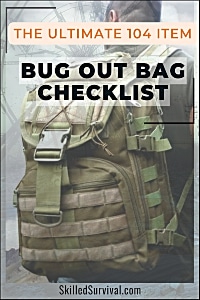
Want a free 104 item bug out bag checklist?
Enter your email below to instantly download this Complete Checklist PDF. No purchase necessary. 👇 👇Hatchet vs. Knife
There are just some things you won’t be able to do efficiently enough with a survival knife alone.
Sure, you can do most things with a good survival knife, but as Rocky Mountain Bushcraft states in their thorough hatchet vs. knife article:
One thing is certain though, when it comes to pure chopping power, hatchets are clearly the undisputed “king.”
If you have a well-designed hatchet with a sharp blade (and have the room in your pack), I suggest you add one.
I shouldn’t replace a survival knife, but I prefer to carry both if possible.
The Hatchet I Carry
I carry the Gerber 14 Inch Hatchet.
Why? Mainly because it only weighs 22.57 oz. (1.4 lbs.).
If you’ve read many of my blog posts, you probably know how much I focus on weight and keeping it reasonable.
So, of course, I’m always looking for high-quality, rugged, proven gear that holds up over time but is also lightweight.
That’s exactly what my survival hatchet is: high quality, rugged and lightweight.

Prepare, Adapt & Overcome,
P.s. - I just found out 2 out of 3 Americans don’t feel prepared for a 3 day disaster!!!
I guess this goes to show how modern society continues to embrace ‘living a fragile life.’ What’s crazy is… it’s so easy to fix.
To make sure YOU have the basics, watch our FREE training on “10 Simple Steps To Basic Preparedness” that shows you HOW.
Nothing crazy here… this isn’t doomsday prepping... just the basics every responsible adult should have before a disaster strikes.Why You Can Trust Skilled Survival...
Go here now to review a full breakdown of:
- Who We Are
- Our Credentials
- Our Mission
- & Product Recommendations...
Here are a few highlights of our teams credentials & certifications:
- Certified Member of a Mountain Search & Rescue Organization
- Plant Emergency & Safety Leader for a Major Food Manufacturer
- Member of the 10TH Mountain Division Hut Association
- Certifications: Avalanche 1, WFR, CPR
- Official Gear Tester for Numerous Outdoor Gear Companies
- Countless Multiday Backpacking trips into Remote Wilderness
- Bachelor's Degree In Mechanical Engineering
- Bachelor's Degree In Civil Engineering
- Bachelor's Degree In Biomedical Engineering
"It takes 20 years to build a reputation and five minutes to ruin it." - Warren Buffett
We're fully aware that trust is NOT something you GET but is EARNED.
And we'll continue to earn YOUR trust through our forthright and honest approach with each new Blog Post, Guide & Product we create...
P.s - I just took this FREE 60-second 'Readiness Score Quiz'👇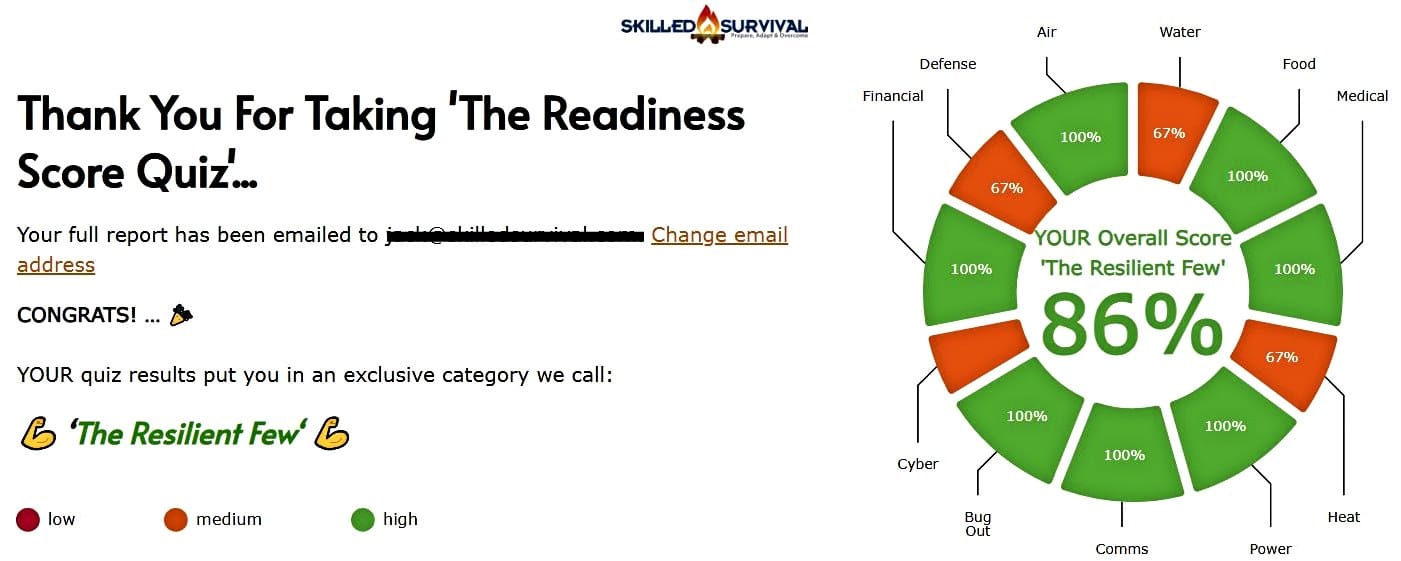
AND... I've still got a few gaps in my preps...🤔 But at least, I'm not part of 'The Fragile Masses'. 👍 Find out where YOU stand by answering a few questions...

Recommended Reading
LifeStraw Review: An Expert Puts It To The Ultimate Test
LifeStraw Review - with no moving parts, chemical additions, or batteries, it provides a lightweight, compact filter to treat up to 4000L...
Best Survival Bow: 16 Surprising Reasons YOU Should Get One
A survival bow is one of the most underappreciated weapons I think EVERYONE should own. Here are 16 reasons why YOU should get one today.
Best Survival Radios: Why You Must Secure One (before SHTF)
Be the ONE who knows what the hell is going on after SHTF. Here's how to set yourself up with a reliable survival radio in a future disaster.
Best EDC Flashlight: Simple, Small, Compact & Super Bright
The best edc flashlight is durable, bright, compact and worth carrying! In this guide, we review the best one to make your search easy.
11 Proven DIY Survival Gear Projects ANYONE Can Follow
Building DIY survival gear doesn't NEED to be complicated to be effective. Here are the 11 best projects you can finish in just a few hours.
Is Tap Water Safe To Drink? The Truth Behind The Lies
Is your tap water really safe to drink? This guide provides a definite answers and a simple solution you can implement immediately.

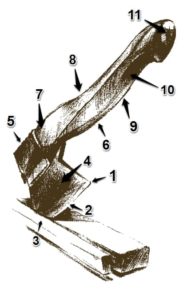 Heel of Bit
Heel of Bit